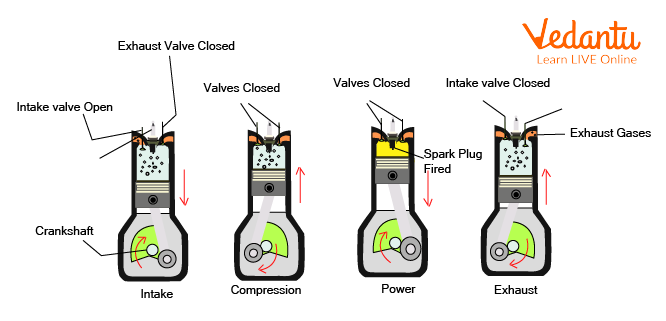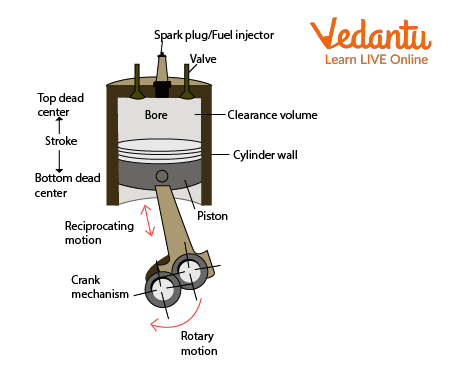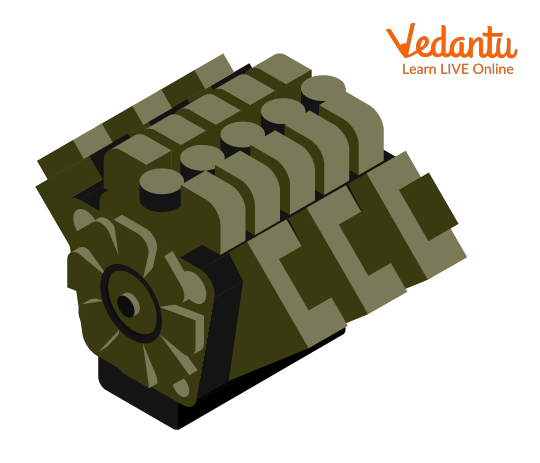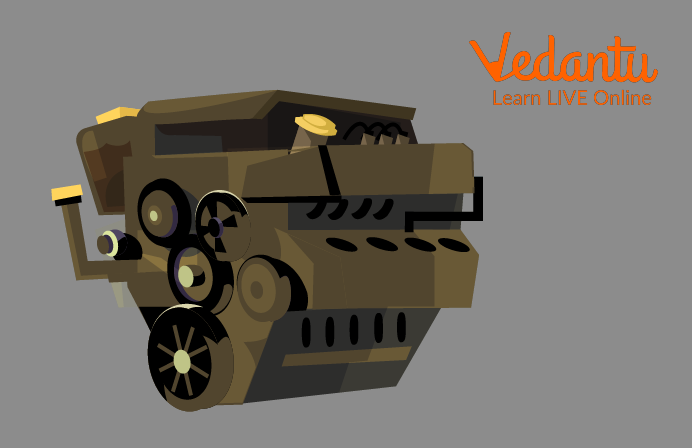




An Overview of Engine Work
Cars, aircraft, lawnmowers, and other machines are all powered by internal combustion. Burning is the definition of combustion. An internal combustion engine operates through the burning of fuel, typically gasoline. Internal-combustion engines are more powerful and lighter than earlier steam engines. They made it possible for cars to exist.
Étienne Lenoir, a French inventor, created the first internal combustion engine in 1860 and installed it in a vehicle. German engineer Nikolaus Otto created a four-stroke engine in 1876. The first successful internal combustion engine was Otto's creation. The diesel engine was created around 1890 by Rudolf Diesel, another German engineer.
In this article, you will learn about engines and their types and functions, and also about the petrol engine working.
What is Engine?
The answer to the question of what is an engine is:
An engine is a device that changes the energy from a fuel into mechanical energy, which in turn generates motion. In the case of cars, gasoline and diesel are the most common fuels used by engines, such as the ones that power them. Alternative fuel types do exist though, including natural gas and biofuels. Engines that generate macroscopic motion from heat are commonly referred to as heat engines in thermodynamics. In this instance, heat is produced as a result of the engine's fuel burning, which drives the pistons.
How Engine Work?
A moving component called a piston slides up and down in a cylinder in many internal combustion engines. Four to eight cylinders are the norm for car engines. A cylinder's top has valves that let air and fuel in and allow burned fuel to escape. A spark plug is also located at the top of the cylinder. The fuel is lit on fire by the spark plug.
The four strokes of the engine's cycle are
Intake,
Compression,
Combustion, and
Exhaust.
A valve opens during the intake stroke, allowing fresh fuel and air to fill the cylinder.
The piston then advances toward the top of the cylinder during the compression stroke. By compressing the fuel and air while keeping both valves closed, the piston produces pressure.
When the piston reaches its maximum height, the fuel burns by a spark from the spark plug. The piston is then forced back down during the combustion stroke, also known as the power stroke, by an explosion of fuel burning. A second valve opens during the exhaust stroke, causing the piston to rise.
It pushes the hot gases from the burned fuel out of the cylinder.

Four-Stroke cycle
The motor shaft, an exterior to the cylinder engine component, is connected to the piston. The piston turns the crankshaft as it moves. Other components that power the machine are connected to the crankshaft.
The internal combustion engine diagram is given below which explains the working and functions of the following parts:
Two-stroke, diesel, rotary, and generator internal combustion engines are additional varieties. Two-stroke engines use two strokes as opposed to four. The fuel burns in diesel engines due to hot air, not a spark. A rotating component serves as the engine's piston in rotary engines. Air is continuously drawn into the front of turbine engines, which are used in jet aircraft. At the rear of the engine, the exhaust exits.
Despite their strength, internal combustion engines lose most of the energy from burning fuel as heat. To prevent the engines from overheating, water or air cooling is required. This is how engine works.

Internal Combustion Engine Diagram
Types of the Most Common Car Engines
The most common types of car engines are as follows:
Inline or Straight: The most typical engine in cars, SUVs, and trucks is this one. The engine is small and efficient because the cylinders are upright and placed side by side.

Straight or Inline Engine Layout
V: With the cylinders at a 60-degree angle, V engines resemble a "V." They can fit a lot of cylinders and are common on expensive or high-performance supercars.

V-Engine Layout
Flat: The cylinders of an engine with this configuration are also referred to as "boxers." This fashion is supported by gravity. Most Porsches have flat engines, which are uncommon.

Flat Engine Layout
Summary
The heart of an automobile is its engine. The energy needed to drive the car is created by converting fuel. It needs pure air to activate the fuel, clean water to cool it, electricity (which it produces), and oil to lubricate it in order to function. It is started by a starter motor and battery.
In the above article, you read about what an engine is, it's working, and the types of car engines.
FAQs on Working of an Engine
1. What is the fundamental working principle of an engine?
The fundamental working principle of an engine is to convert chemical energy into mechanical energy. In an internal combustion engine, this is achieved by burning a fuel (like petrol or diesel) in a confined space, which creates high-pressure gas that pushes mechanical components, ultimately generating motion.
2. How does a four-stroke internal combustion engine work step-by-step?
A four-stroke engine completes one power cycle in four movements (strokes) of the piston. The steps are:
- Intake Stroke: The piston moves down, drawing a mixture of fuel and air into the cylinder through an open intake valve.
- Compression Stroke: Both valves close, and the piston moves up, compressing the fuel-air mixture to increase its potential energy.
- Power (or Combustion) Stroke: A spark plug ignites the compressed mixture, causing a small explosion. The force of this explosion pushes the piston down, generating the power that turns the crankshaft.
- Exhaust Stroke: The exhaust valve opens, and the piston moves up again, pushing the burnt gases out of the cylinder.
3. What is the primary function of an engine in a vehicle?
The primary function of an engine in a vehicle is to generate the rotational force, or torque, required to turn the wheels. It acts as the heart of the vehicle, providing the power needed for acceleration and to overcome forces like air resistance and friction, allowing the vehicle to move.
4. What are the main parts of an engine and their functions?
The main parts of a basic internal combustion engine include:
- Cylinder: The chamber where fuel combustion takes place.
- Piston: A component that moves up and down inside the cylinder, pushed by the force of combustion.
- Spark Plug: Delivers an electric spark to ignite the fuel-air mixture in a petrol engine.
- Valves (Intake & Exhaust): Control the flow of the fuel-air mixture into the cylinder and the flow of burnt gases out of it.
- Crankshaft: Converts the up-and-down (linear) motion of the pistons into rotational motion to power the car.
5. What are the three common types of car engines based on cylinder arrangement?
The most common car engine types based on how their cylinders are arranged are:
- Inline (or Straight) Engine: Cylinders are arranged in a single straight line. This is a simple and common design.
- V-Engine: Cylinders are arranged in two banks, forming a 'V' shape. This layout is more compact and can accommodate more cylinders.
- Flat (or Boxer) Engine: Cylinders are arranged horizontally, lying flat on opposite sides of the crankshaft. This provides a low centre of gravity.
6. What is the main difference between how a petrol engine and a diesel engine work?
The main difference lies in the method of ignition. A petrol engine uses a spark plug to ignite a pre-mixed fuel-air mixture. In contrast, a diesel engine first compresses only air to a very high temperature and pressure. Fuel is then injected into this hot, compressed air, causing it to ignite spontaneously without a spark plug.
7. Why do internal combustion engines get very hot and need a cooling system?
Internal combustion engines get extremely hot because the burning of fuel is a highly energetic process. However, only a fraction of this thermal energy is converted into useful mechanical work. The rest is wasted as excess heat. A cooling system (using air or liquid coolant) is essential to dissipate this heat and prevent the engine components from overheating, warping, or melting, which would cause catastrophic engine failure.
8. In a four-stroke cycle, which specific stroke provides the power to move the car?
The stroke that provides the power to move the car is the Power Stroke, also known as the Combustion Stroke. This is the only one of the four strokes where energy is produced. The explosive force from the ignited fuel pushes the piston down, turning the crankshaft and generating the power that is eventually transferred to the wheels.
9. What would happen if the exhaust stroke in an engine cycle failed?
If the exhaust stroke failed, the burnt gases from combustion would be trapped inside the cylinder. This would prevent a fresh mixture of fuel and air from entering during the next intake stroke. Without a fresh charge to combust, the engine would not be able to produce power in the subsequent cycle and would quickly stall or stop running.
10. Why is using the correct oil for lubrication crucial for an engine's health?
Using the correct oil is crucial because it performs several vital functions. Its primary role is lubrication, which creates a thin film between moving parts to drastically reduce friction and wear. It also helps to clean the engine by carrying away debris, cools critical components by absorbing heat, and prevents rust and corrosion. Using the wrong type of oil can lead to inadequate protection, increased friction, overheating, and ultimately, severe engine damage.









